
MORE SPIRIT ROVER EVIDENCE
Report #172
November 6, 2009
Addendum Added 11/28/2009 to End of Report
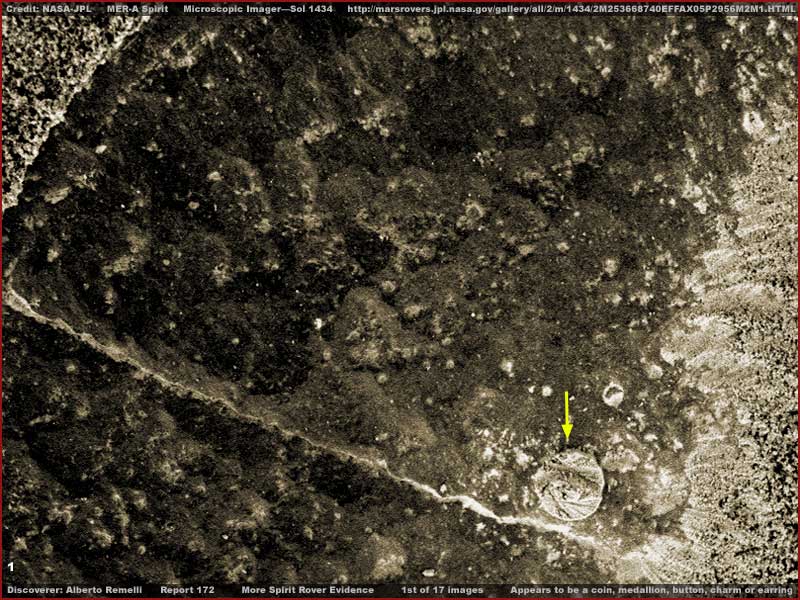
http://marsrovers.jpl.nasa.gov/gallery/all/2/m/1434/2M253668328EFFAX05P2936M2M1.HTML
The above large 1st image demonstrates
a small shallow pit drilled in a rock via Spirit rover's onboard RAT (Rock
Abrasion Tool) tool that is located on the rover's articulating arm as are
the Mössbauer and alpha particle X-ray spectrometers that do geological
testing associated with such drillings as well as the Microscopic imager that
took this image. The most important anomalous evidence here is of course the
obvious small round disk pointed with the yellow arrow.
As you can perhaps tell by the visuals here, it seems that the RAT was pressed
down at an angle cutting a bit deeper on the left than on the right as the
rounded cut line edge on the left is more defined in the rock than on the
right. I mention this because the pit and the rock will both also be a bit
of issue here and will be needing some attention as you will come to understand.
Yes it would have been better if the above image offered a bit wider field
of view showing more of the outer edges of the pit but the close in shots
do not allow for this in any of the images. The shot here is taken from one
side edge of the strip to the other side and encompasses all the visual available.
Before leaving this image and moving on, note the interior bottom of the shallow
pit and its lumpy surface. Note that it looks possible that this may have
been a bit of a hollow pocket uncovered by the RAT once the surface cover
material was removed. The straight thin light color ridge line looks anomalous
because it is so straight but it may be nothing more than an old fracture
line that was filled in by fine sediment and then hardened in place in older
times becoming harder than its softer surroundings. Now also take note of
the rocky surface material on the right edge area and how it looks. We'll
be getting into that a little later.
Also you should know that this object was brought to my attention for investigation
by Alberto Remelli of Verona, Italy. Good work and well done Alberto.
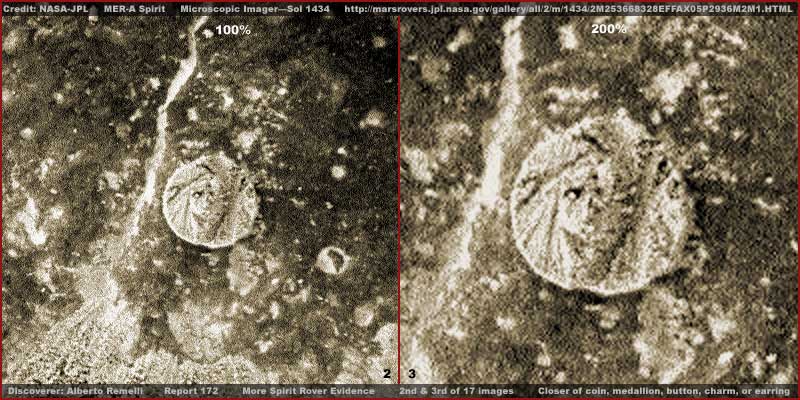
http://marsrovers.jpl.nasa.gov/gallery/all/2/m/1434/2M253668328EFFAX05P2936M2M1.HTML
As you can see in the above 2nd
and 3rd split frame images providing closer views of the disk evidence only,
the disk clearly appears to have a raised relief on the surface and a visage
of something or someone represented there. You should know that the RAT cuts
a nearly 5 cm or 2 inch wide pit as much as 5 mm or .2 inch deep and these
images are from the close in Microscopic Imager. That means that this disk
object is very small and likely smaller than a dime coin.
I suspect the RAT's metal cutter/grinding wheel kicked this object up out
of its resting place in the matrix it was embedded in. In the process, the
object was likely damaged and defaced even as the rotating RAT brushes partially
cleaned its surface. In the upper right area of the disk, you can see what
appear to be cut marks on the disk's edge. This likely continued down vertically
across the disk face damaging it.
Remember that the RAT cutter is designed to cut through hard rock in a clockwise
rotation and so this object would not likely escape some defacement and some
matrix is likely still sticking to the object. On the other hand, note that
the object would likely have come to a quick rest when it was carried to the
right drill area where the RAT was cocked upward and dropped downward away
from the cutter.
This may in fact be a small coin, a medallion, a button, a small charm, or
even an earring. This is obvious the front and we can't see the back of it
to check for attachment points. Take a look at the following EARTH
ancient coins for a design comparison.
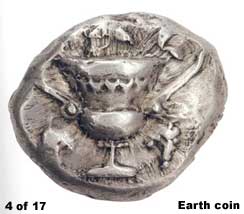 ,.
,. 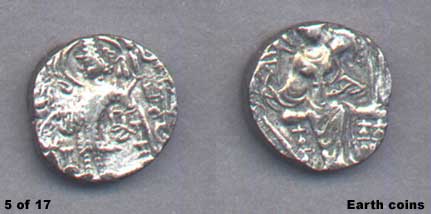
http://www.greek-islands.us/ancient-greek-coins/naxos-coins
...................... http://www.ancient-art.com/east.htm
As you can see by the above 4th
and 5th image examples of small ancient coins and the 6th image of ancient
buttons here on Earth, raised relief and a rimless
design is a typical feature of such small Earth artificial disks. The various
samples I've used above were chosen for their variety and rimless designs,
irregular edges, and raised relief. They demonstrate that not all such designs
depict the visage of a person even though person depictions are the most common
and I suspect most viewers will see a face raised relief in the Mars disk
evidence in this reporting.
You should also think about this. This object appears to laying free on the
base lumpy interior bottom of the shallow pit. It may be laying free of its
context geological material now but I doubt that it was originally this way.
No doubt this object has been spun around in this shallow pit by both the
RAT cutter and both of the RAT metal brushes. Assuming a RAT clockwise spin,
it is logical that the disk dislodged from its context material bounced around
to the right side of the pit where it lodged against the raised thin ridge
line bisecting the pit. The RAT more raised in this right area would have
had less contact with the disk allowing to come to a rest even if a bit defaced
in the tangle with the RAT cutter head.
So it is also logical to suspect that the origin of the disk dislodged from
its context material probably probably originated from the left side of the
drilling pit where the RAT was pressed down cutting deeper. So now let's look
closer in the image below at the left side of the pit and see if we can see
anything else interesting over there.
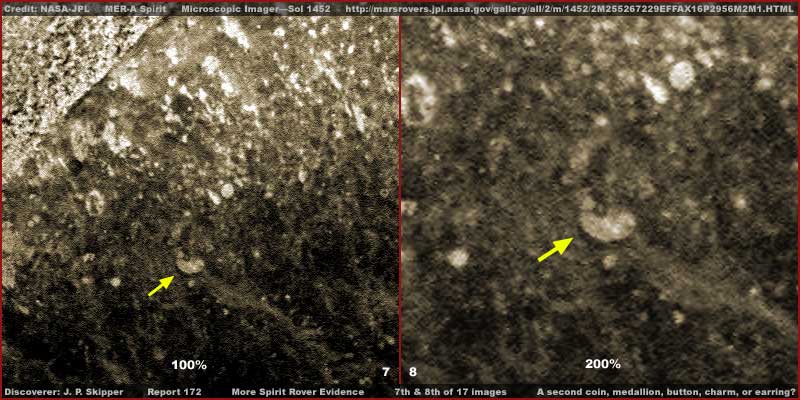
http://marsrovers.jpl.nasa.gov/gallery/all/2/m/1452/2M255267229EFFAX16P2956M2M1.HTML
Sure enough in the above 7th and 8th split frame image the left side of the pit reveals some suspicious evidence the chief of which is the disk looking object pointed out by the yellow arrow still partially buried in the matrix. Note in the 8th closer image that there may be a projection object on this disk. This may be an attachment point and so this could be a small charm, button or earring we are seeing the backside of. In fact, it could be a pair companion to the primary disk looking object pointed out in the 1st, 2nd and 3rd images further above.
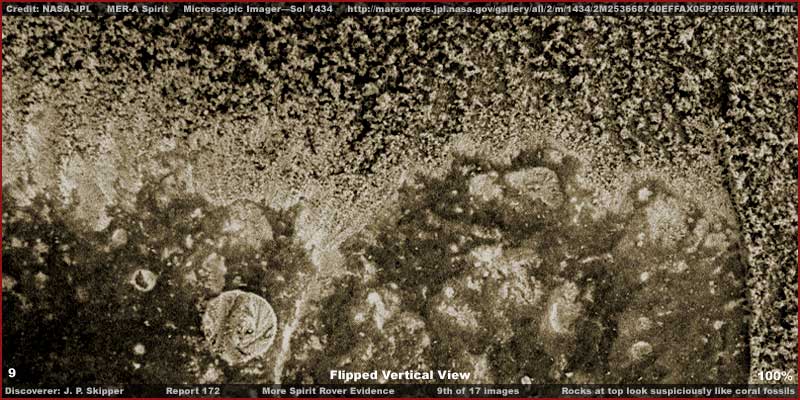
http://marsrovers.jpl.nasa.gov/gallery/all/2/m/1434/2M253668328EFFAX05P2936M2M1.HTML
The above 9th image demonstrates
a flipped closer view of the right side of the pit area as shown in 1st image.
What I want to draw your attention to here is the rock matrix in the top of
this image. I've seen this type of rock before in the Florida Keys where I
spent 10-years and a lot of exploring. It looks quite a bit like coral fossil
rock both as to its top surface and the sides of the rock where it goes down
to the pit bottom near the disk like object.
The implication is that this disk looking object may be very old to ancient.
If it is a artificially made object as it appears to be, it may have gone
to the bottom when shallow salt water covered this area and eventually coral
growth in the shallows covered it over sealing it into the bottom matrix.
Then long ago the water conditions retreated leaving this in dry terrain to
be uncovered by the RAT drilling here in this time.
The only trouble with such musing is that the more distant view of the rock
the RAT drilling is presented to us as happening to doesn't look very much
like coral rock. This impression is further communicated by the "pocket"
and "cavity" look of the bottom area of the RAT drill pit. In fact,
the lack of sufficient drilling dust and debris present around the drill site
presented to us in the official data even brings up the question of whether
the spot documented was even drilled by the RAT. Yet look at the next image
below tending to confirm that at least the close in evidence indicates that
is is a RAT drilled site.
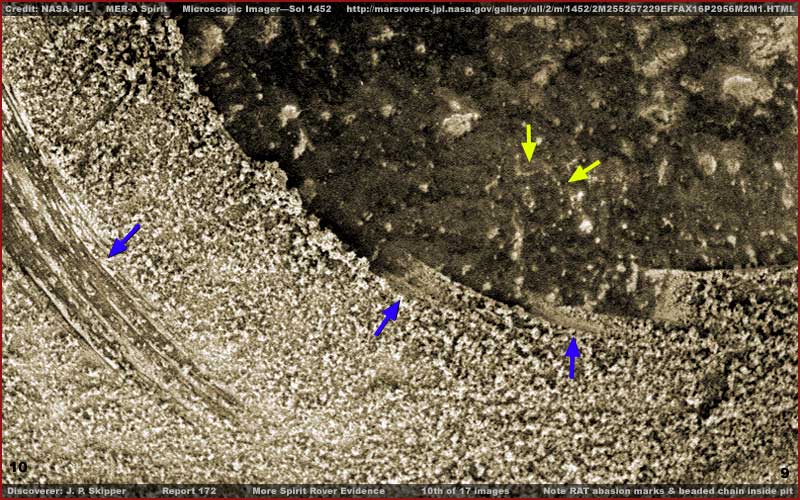
http://marsrovers.jpl.nasa.gov/gallery/all/2/m/1431/2M253403030EFFAX05P2956M2M1.HTML
In the above 9th image, note the
drill abrasion marks pointed out by the blue arrows at the pit's perimeter
areas. This evidence of course tends to support that this is in fact a RAT
drilling site. The only problem is that the Microscopic Imager images are
always too close giving little away as to the wider site area and the more
distant shots by the Panoramic shots are too much visually compromised by
poor resolution even though the site is near the rover and the images should
be clear. That alone makes me suspicious.
On the other hand, note the evidence the yellow arrows point out in the pit
bottom. It looks very much like a section of a very small beaded chain doesn't
it. Could the disk evidence here be associated with charms on a beaded chain
that someone in the ancient past wore? That's very powerful suggestive visual
evidence ripe with implications isn't it.
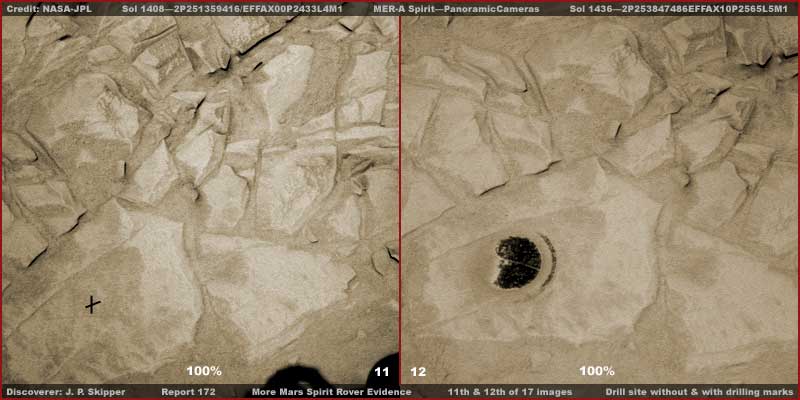
http://marsrovers.jpl.nasa.gov/gallery/all/2/p/1408/2P251359416EFFAX00P2433L4M1.HTML
- left panel
http://marsrovers.jpl.nasa.gov/gallery/all/2/p/1431/2P253399517EFFAX05P2564L4M1.HTML
- right panel
As you can see in the above 11th
and 12th side-by-side images, the left panel shows the rock in question without
any drill marks on it on Sol 1408 while the right panel shows the same rock
on Sol 1436 some 28 days later with the RAT drill marks in it and the pit
bottom now fully exposed. Note the straight light color line bisecting the
pit and the reflectivity of the round disk on the left side of the pit confirming
this as the site.
I didn't have the image room to show it here but I urge you to access the
above second link for the right panel and look at the larger field of view
of the official image the above right panel was sourced from. It will show
a portion of the rover in the bottom of the frame completely with JPL labeling.
Remember that the drill hole is suppose to be "nearly 5 cm or 2 inches
in diameter." Using the rover as a frame of reference, doesn't that dark
color drill pit look a lot larger than that to you? It certainly does to me.
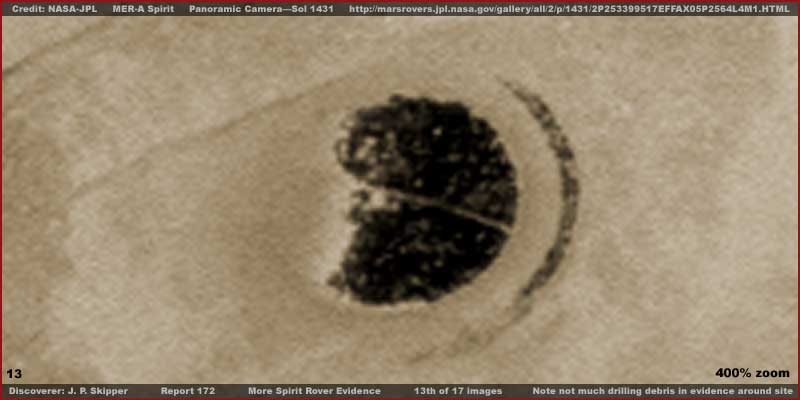
http://marsrovers.jpl.nasa.gov/gallery/all/2/p/1431/2P253399517EFFAX05P2564L4M1.HTML
The above 13th image demonstrates
a 400% closer view of the drill site in question here as viewed by the rover
panoramic camera. Note how vague and blurry the terrain around the drill pit
looks even though the camera is only a short distance from the target. Because
the resolution is so poor and blurry, it's hard to tell but note that there
really doesn't seem to be any piling up of drilling dust and debris around
the drill pit. I find this suspicious and it causes me to suspect but can't
prove that the drill pit surroundings do not belong with the drill pit.
You should know that just a few feet away are two other drills sites not to
be confused with the drill site reported on here. Neither demonstrate this
coral rock appearance geology. The makes me suspicious that maybe the above
more distant view is not real? That kind of suspicion makes it easy to speculate
and consider questioning whether the true drill site is on the edge of some
body of water evidenced by the coral rock structure and maybe the above individual
rocks shown by the panoramic camera are not the true drill site?
Now take a look now at the following images that will help bring you up to
speed both as to the RAT itself, its drilling features, and the typical drill
site look. Note that the RAT is developed and operated by Honeybee Robotics
here in the USA.
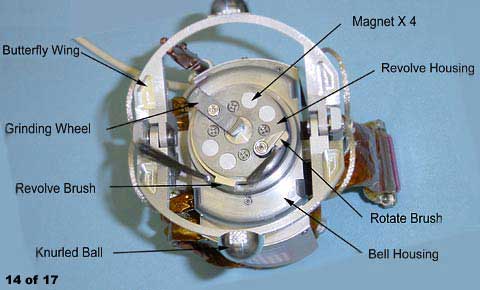
http://www.hbrobotics.com/rat.html
http://athena.cornell.edu/the_mission/ins_rat.html
The above 14th image demonstrates the business end features of the RAT. Note in particular the small cutter/grinding wheel and the small brush that rotates with the grinding wheel designed to sweep out the interior of the drilled pit. Note also the larger longer brush that rotates on an outer housing designed to sweep away dust and debris around the drill hole. Note that both the inner and outer brush orientations confirm a clockwise rotation when pointed down at the ground.
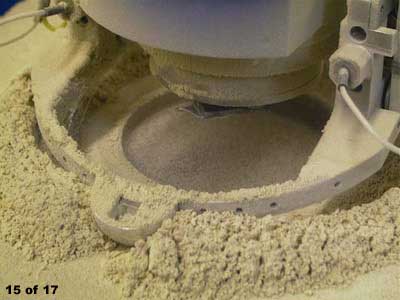
http://athena.cornell.edu/the_mission/ins_rat.html
http://www.hbrobotics.com/rat.html
The above 15th image demonstrates a typical rock drilling which in this case is limestone and in a lab setting here on Earth. Note how much dust and debris is generated by a typical rock drilling. Note that the outer position metal ring limits how far away the outer brush can push away the dust and debris where it piles up outside the positioning metal ring.
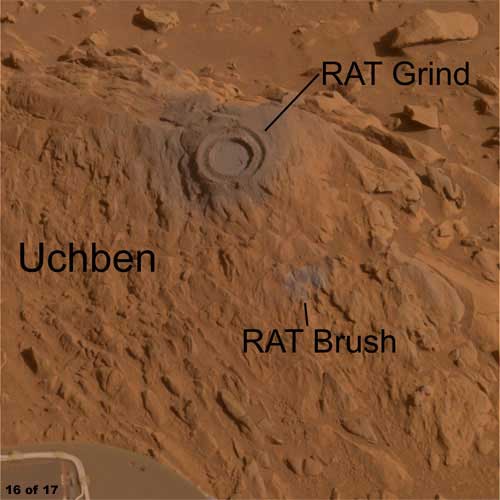
http://athena.cornell.edu/the_mission/ins_rat.html
http://www.hbrobotics.com/rat.html
The above 16th image demonstrates two kinds of drilling on Mars at another site not associated with this one. The top one is the full use of the RAT drilling a pit. Note the clear piling up of the dust and debris with the clear imprint of the outer position metal ring in that dust and debris. Note that to the nearby lower right of that drill site is a spot where only the RAT brush was used to sweep off a spot. As you can see, this last use of the RAT demonstrates that a delicate touch in the drilling process is apparently possible with this tool. These are examples of what the two principle RAT drillings generally look like for your reference.
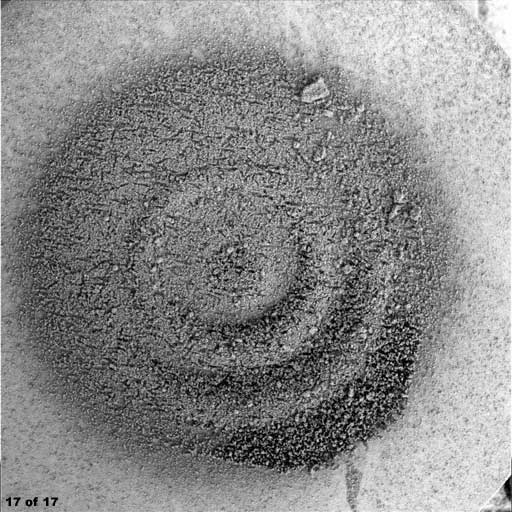
http://marsrovers.jpl.nasa.gov/gallery/all/2/m/1355/2M246651970EFFAVQWP2956M2M1.HTML
The above 17th image demonstrates
the beginnings of what the RAT drill site looks like and specifically for
the evidence presented here in this reporting. As you can see, even though
the pit is not complete or as deep as it is going to be as of Sol 1355, it
demonstrates that the drilling debris will be substantial and consists not
just of dust but of fine pebbles and exhibits a fairly evenly applied downward
pressure.
However, the context views of the drill site in question here show a RAT downward
pressure off balance deeper on one side and nearly non existent on the other
side. Likewise, the drill site under question here appears to be free of perimeter
dust and debris that should be there. In other words, the deeper and more
careful one looks, the more inconsistencies one finds. Again, these inconsistencies
tend to bring up questions as to whether the wider field of view context panoramic
camera images supposedly of this drill site and the terrain around it are
truly the same as the Microscopic Imager images.
I suspect they aren't but can't really be conclusive about this. For example,
it may not be but it is possible that the rover repositioned its articulating
arm becoming more offset in drilling this hole deeper after the above drilling
progress was imaged. Also, it is possible that those operating the RAT and
the articulating arm the RAT is on may have a delicate enough touch to use
the RAT larger brush to move around the site sweeping off a wider area around
the drill hole to make the accumulating dust and debris around the hole visually
go away.
I keep thinking about that coral looking rock presence. If you were a secrecy
type operating the rover around a body of water that produced coral evidence
in older times in the older shore areas now retreated away from, you would
not be showing that in the wider view context imaging and would be substituting
something else visually to obfuscate the reality. Likewise, if you encountered
an old long ago decomposed corpse and a pocket near it with some shiny objects
in it, you might just stick your rover articulating arm down there and dig
around.
The Microscopic Imager very close views would not show any unacceptable information
further than 3-inches outside the hole but the panoramic camera would and
would have to be dealt with. Just a thought. Yes, I'll admit it, I'm not much
for accepting things at face value and especially when I suspect someone is
trying to get something by me.
By the way, don't come back to me and point out all of the other objects in
this drill pit that might be artificial. I am aware of them but I report only
on what I consider the most obvious and strongest evidence that I believe
that most viewers can see and recognize as is my way. The rest is more interpretive
and up to individual perception.
ADDENDUM by Chandre Roux
(posted 11/28/2009)
OK, I am going to have to start believing in a Liliputian race on Mars. (Only
joking as after much research there seems to have been a similar race on Earth)
The RAT circular measurement is 4.5cm, which means this 'coin' is tiny. I
am not sure of the exact size (maybe someone can help) but I find the detail
fascinating. I see a face, but I guess that would be normal. In an attempt
to understand what I am looking at I did some homework on ancient earth coins
that are similar but larger of course.
I came across some coins that were similar from the city of Idyma which was
part of the Caria civilisation located in present-day Turkey. Not much is
known about this civilisation but by the looks of the coins they were minting
they seem to have been both technologically advanced and very interesting!
Two in particular caught my eye in comparison to the Mars ones, the others
are just being included for interests sake.
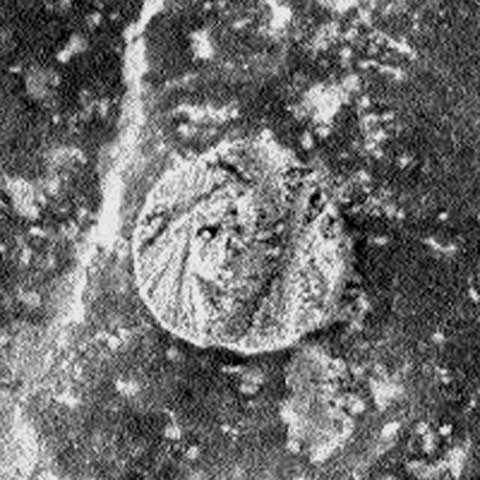
Are those
glyphs on the bottom right of the coin?
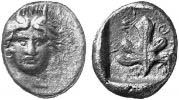 ...
... 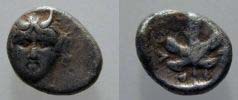
Idyma, at the head of the Ceramic
gulf, is mentioned several times in the Athenian Quota-Lists. In B. M. C.,
Caria, p. lxi, some archaic drachms of Aeginetic weight are conjecturally
assigned to this town, but its earliest inscribed coins are drachms and smaller
silver coins of the Phoenician standard which seem to range from about B.C.
450-400.
The following is included as a footnote just because its interesting. Other
Caria/Idyma coins and a bit of history (note dates for historical context)
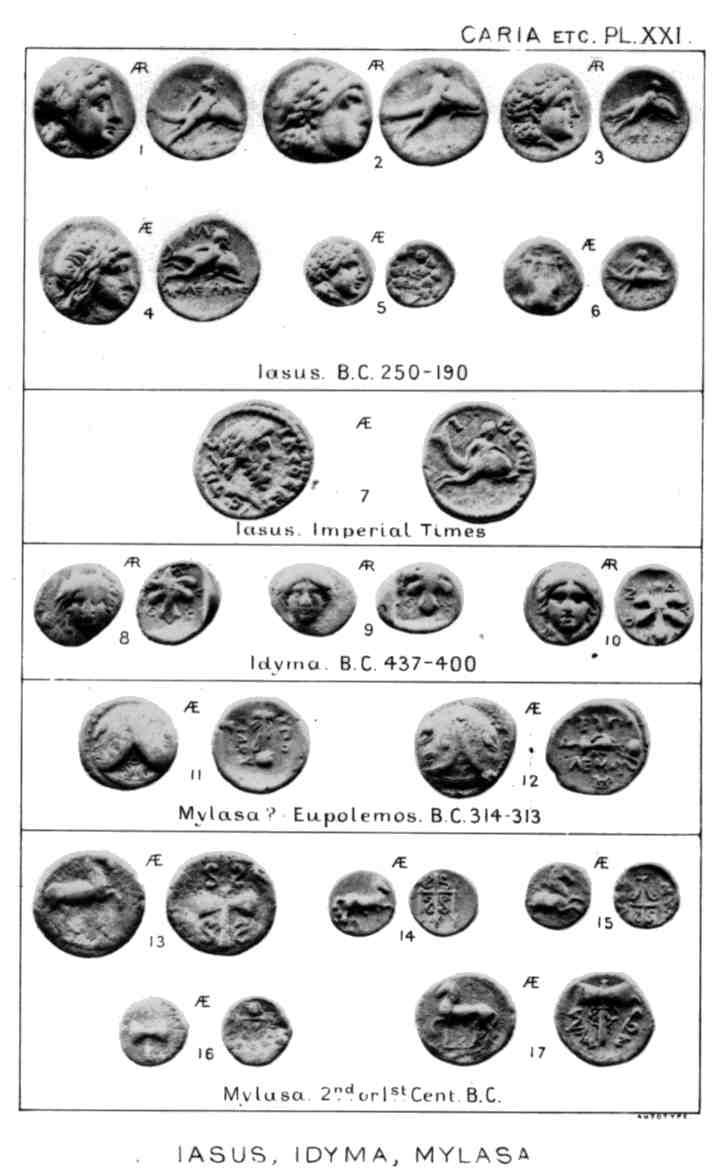
http://www.snible.org/coins/bmc/caria/XXI.jpg
The man appearing to be swimming with a dolphin on the coins seems to be significant..
http://www.snible.org/coins/hn/caria.html
The boy and dolphin as a coin-type of the Iasians is mentioned by Aelian (Hist. Anim., vi. 15), Plutarch (De solert. Anim., 36) and Pollux (ix. 84). The story of the love of a dolphin for a youth of Iasus, who is called Hermias by Plutarch and Pliny (N. H., ix. 8), and Dionysius by Athenaeus (xiii. 606), may have had an historical basis, for Alexander the Great is said to have ordered the boy to be sent to his court.
ABSOLUTELY TINY GREEK AND PHOENICIAN SILVER COINS AND A BIT OF HISTORY
All the excerpts below are taken from the following web-site, this is well worth a visit as it has many more images and information on this subject.
http://dougsmith.ancients.info/tiny.html
Very small denominations meant very small coins. The most common small denomination was the obol (1/6th drachm) weighing around .8g. Pictured below are eight coins each valued at less than one obol. Different issuing authorities issued coins on different weight standards and it is not always certain what to call a certain denomination. The artwork on these tiny coins is every bit as great as the larger issues and, considering their size, the detail is amazing.
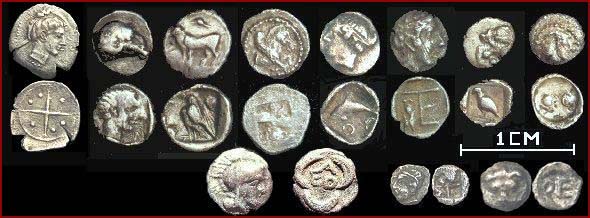
Left to right (top row
= obverses; second row = reverses):
1. Syracuse, Sicily, hemilitron 440-430 BC, .3g
2. Salamis, Cyprus, hemiobol? (1/2 obol), 445-411 BC ?, .5g
3. Paphos, Cyprus, King Stasandros, 1/24 stater, c. 450BC, .4g
4. Therma, Macedon, hemiobol (1/2 obol), 510-480 BC, .3g
5. Thasos, Thrace, hemiobol (1/2 obol), 411-350 BC, .2g
6. Kolophon, Ionia, tetartemorion (1/4 obol), 430-400 BC, .2g - This coin
is unusual in the monogram 'TE' on the reverse (over the cicada) indicating
the denomination.
7. Uncertain city, Ionia, tetartemorion? (1/4 obol), 5th century BC, .1g
8. Syracuse, Sicily, Tyrant Gelon, hexas (1/6 litra or 1/300th of the popular
dekadrachm), 485-478 BC, .05g? This is the smallest coin I have ever seen
but the flaking surface of this specimen makes its weight lower than normal.
Bottom Row:
1. Athens, Attica, tritartemorion (3/4 obol), 393-300 BC, .5g
2. Phocaea, 1/8? obol discussed below
3. Rhegion, Bruttium, hemitatemorion (1/8 obol), 466-415 BC, .1g.
The next photo shows a coin resting on a US cent for size. The two sides were
photographed on the same cent with the halves joined in the software. While
this coin is my smallest in diameter, its greater thickness causes it to weigh
more that the Syracuse hexas
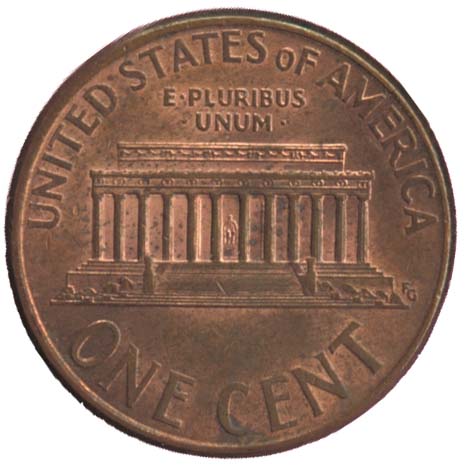
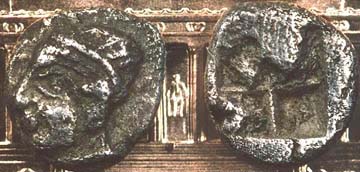
Phocaea, Ionia - Silver 1/8 obol? - Late Sixth Century BC - 5mm, .1g
Female head 'Smyrna type' left / 4 part incuse - Rosen 598
Another coinage system that left us small silver was that of Phoenicia. This 9mm, .7g coin of King Adramelek of Byblos (Gebal) was a 1/8 shekel bears a complete legend in Phoenician. Catalogs list the types as a galley sailing above a hippocamp on the obverse and a lion attacking a bull on the reverse. Larger denominations do look more like a bull than this coin which almost seems to show a goat. This is a lot of detail to fit in so small a space so we can understand that what seems to be a minor variation is probably accidental. The same coin is available in a large (and popular) dishekel that shows even more detail.
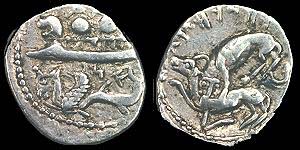
The above addendum is
additional good solid research work supplied by Chandre Roux of South Africa.
It deals with Earth historic coins as metal disc objects with strong relief
on them as an interesting comparison. It also demonstrates that Earth coins
have been incredibly small in size in the past as demonstrated by the image
above of two ancient coins superposed on a current U.S. one cent piece. Now
that's really small and an eye opener.
Even so, remember that this does not necessarily demonstrate that the Mars
disc shaped object is a monetary coin. There are a number of very small flat
disc shaped objects that could qualify and Chandre would be among the first
to point this out. Further, the presence of a possible length of beaded chain
in the same hole (image #10) suggests a different path. What is strongly indicated
though is that the Mars disc object strongly suggests artificiality on another
world.
, Investigator
and Chaudre Roux, Contributor
![]()